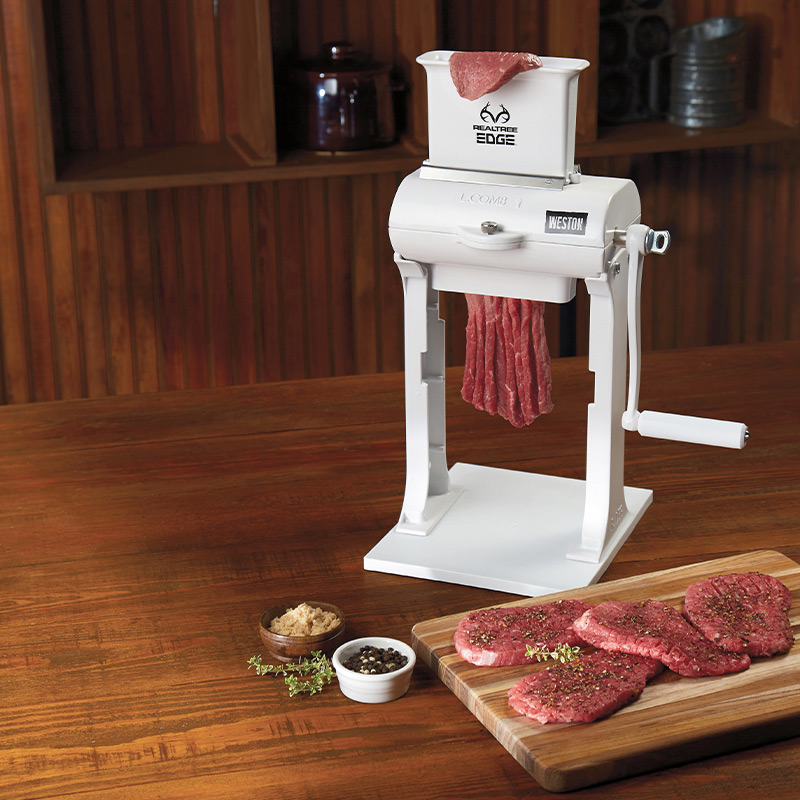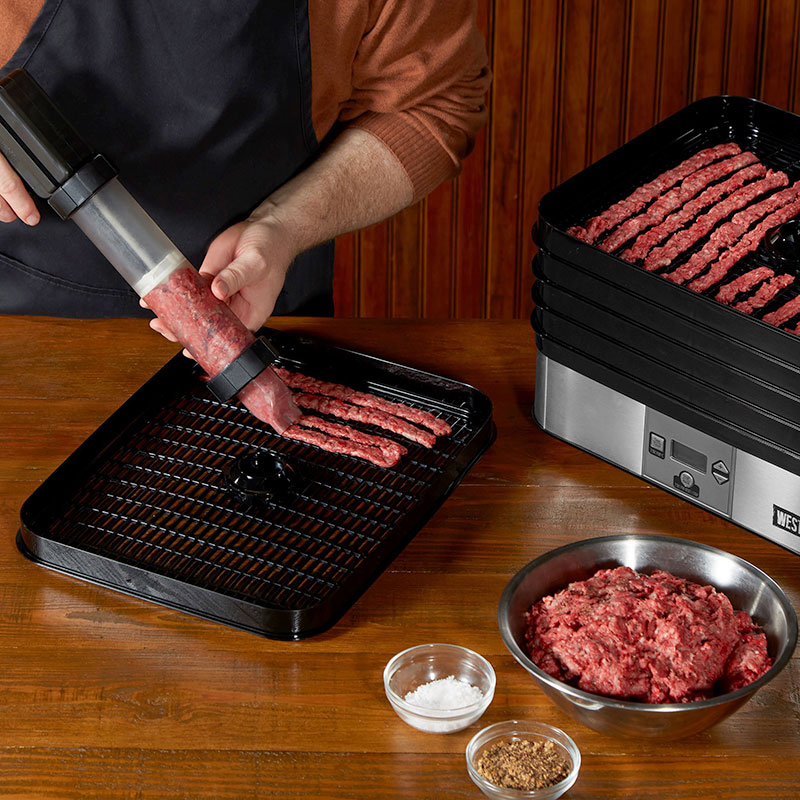I Pound of Beef Equals Hw Much Jerkey
Move over, potato chips. Beef jerky is gaining ground and may soon be Americans' favorite salty snack. There are many reasons behind the increased popularity of meat jerky: people are snacking more rather than sitting down to meals, and high-protein diets, from Atkins to Paleo to Keto, continue to grow in popularity.
Even the beautiful people who once nibbled on rice cakes are now chomping on dried meat, and one of them, Elizabeth Hurley, has her own brand of beef jerky. What's more, many endurance athletes have turned away from carbo-loading in favor of a more protein-centric diet. Meat jerky has become a popular among long-distance cyclists, who snack on it during and after long training rides to ensure they're getting enough protein.
As with any food, jerky has its pluses and minuses. It's a great source of protein and, depending on how it's prepared, very low in sugar, which Americans consume in unhealthy amounts. On the downside, commercially prepared jerky can be rather high in sodium and other additives. That's why it's better to make your own jerky—not only will you know the source and quality of the meat that goes into it, you can also control the salt and seasonings while skipping the polysyllabic preservatives entirely.
Jerky 101: How to make jerky
 For those new to the art of drying meat, there are two main types of jerky—whole muscle and formed (also called "fragmented"). Whole muscle jerky uses meat that is sliced, seasoned and dried. It's the type most connoisseurs of jerky prefer because it's chewier and more flavorful.
For those new to the art of drying meat, there are two main types of jerky—whole muscle and formed (also called "fragmented"). Whole muscle jerky uses meat that is sliced, seasoned and dried. It's the type most connoisseurs of jerky prefer because it's chewier and more flavorful.
Formed or fragmented jerky uses meat that is ground, seasoned, extruded through a jerky gun and then dried. Formed jerky is softer and doesn't offer the mouthfeel or chewing experience that many people enjoy with whole muscle jerky. But extruded jerky made from ground meat does allow for a more even distribution of seasonings or marinades. It also dehydrates more consistently.
Generally speaking, jerky is made from venison or beef, though poultry and fish are popular too. Here's a guide to making jerky at home.
Tips and tools for making whole muscle jerky
- Start with chilled, nearly frozen meat. Use a quality jerky slicer to create slices that are 1/8- to 1/4-inch thick. Slice with the grain for a chewier jerky and against the grain for a more tender version. If you like a tender jerky, consider using a manual tenderizer on the meat.
- Season meat with our Classic Dry Jerky Seasoning or with a homemade blend. You can use wet or dry seasoning. Some folks also use curing salt to mitigate bacteria, but this step is not necessary if you heat beef or venison to 160 degrees and chicken or turkey to 165 degrees in the oven before dehydrating. If you choose a marinade, marinate meat overnight in the refrigerator. To help the marinade permeate the meat, use a vacuum sealer and place marinating meat in the fridge overnight.
- Place strips of meat on dehydrator trays, close but not touching, and dry until bendable but not brittle, usually 6 to 8 hours at 160 degrees. If they are still moist, keep drying to reduce the chance for mold. Use a multi-tray Weston® dehydrator to make up to 40 pounds of jerky at once.
Tips and tools for making formed or fragmented jerky

- Start with chilled, nearly frozen meat. Use a quality meat grinder and start with a coarse plate for your first grind. Then move to a medium plate. (See more tips on grinding meat.)
- Season meat with our Classic Dry Jerky Seasoning or with a homemade blend. You can use wet or dry seasoning. Some folks also use curing salt to mitigate bacteria, but this step is not necessary if you heat beef or venison to 160 degrees and chicken or turkey to 165 degrees in the oven before dehydrating. If you choose a marinade, marinate meat overnight in the refrigerator. To help the marinade permeate the meat, use a vacuum sealer and place marinating meat in the fridge overnight.
- Load ground, seasoned meat into a jerky gun. There are two tip options on the jerky gun that allow you to make either a jerky stick or a flat strip.
- Extrude strips of meat onto dehydrator trays. Make sure the sticks or strips are close but not touching, and dry until they are bendable but not brittle, usually 6 to 8 hours at 160 degrees. If the jerky is still moist, keep drying to reduce any chance of mold forming. Use a multi-tray Weston® dehydrator to make up to 40 pounds of jerky at once.
Preserving your handiwork
Whether you choose the whole muscle or formed variety, store jerky for a few weeks in a cool dry place or preserve with a quality vacuum sealer for even longer storage. Of course, dehydrating is just one of many preservation methods that can enhance the field-and-farm-to-table lifestyle. Once you've mastered jerky making, learn more about canning, vacuum sealing and techniques for dehydrating foods other than meat. But before you put away those dehydrating tools, give watermelon jerky a try and keep summer going all year long.
 Visit Weston's Field to Table resource page for the latest products, tips and recipes to help you bring the field to your table.
Visit Weston's Field to Table resource page for the latest products, tips and recipes to help you bring the field to your table.
Source: https://westonbrands.com/all-jerky-is-not-created-equal
0 Response to "I Pound of Beef Equals Hw Much Jerkey"
Post a Comment